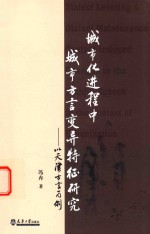

城市化进程中城市方言变异特征研究 以天津方言为例 英文PDF电子书下载
- 电子书积分:9 积分如何计算积分?
- 作 者:冯卉著
- 出 版 社:天津:天津大学出版社
- 出版年份:2015
- ISBN:9787561853580
- 页数:176 页
Chapter 1 Introduction 1
1.1 Dialect Contact Studies:An Emergent Field of Enquiry 1
1.2 Globalization and the Changing Tiānjīn Dialect 2
1.3 Layout of the Book 3
Chapter 2 Language Variation and Change:From Traditional Dialectology to Social Dialectology 5
2.1 The Western Tradition in the Study of Language Variation and Change 5
2.1.1 Historical Linguistic Studies:Achievements and Limitations 6
2.1.2 Sociolinguistic Perspectives 7
2.1.2.1 Variationist Approach 8
2.1.2.2 Social Network Theory 11
2.1.3 Dialect Contact 12
2.1.3.1 Language Contact versus Dialect Contact 12
2.1.3.2 Traditional Dialectology versus Social Dialectology 14
2.1.3.3 Theory and Principles for Dialect Contact 16
2.1.3.4 Processes/Mechanisms of Dialect Contact 18
2.2 The Study of Language Variation and Change in the Chinese Context 20
2.2.1 Philological Studies 20
2.2.2 Sociolinguistic Studies 21
2.2.3 Studies on Tiānjīn Dialect 23
2.2.3.1 Salient Features of Tiānjīn Dialect 24
2.2.3.2 Sociolinguistic Studies on Tiānjīn Dialect 29
2.2.4 Dialect Contact Research 30
2.2.4.1 Deficiencies of Traditional Chinese Dialectology 30
2.2.4.2 Dialect Contact—An Emergent Field of Inquiry in China 31
2.2.4.3 Limitations of Previous Sociolinguistic Researches on Tiānjīn Dialect 33
Chapter 3 The Proposed Framework 35
3.1 Pilot Study 35
3.2 The Framework 36
3.2.1 Language Ideology 40
3.2.2 Linguistic Market 41
3.3 Dialect Leveling 42
3.3.1 Standard Linguistic Market 43
3.3.2 Loose-knit Social Network 46
3.3.3 Process of Long-term Accommodation 48
3.4 Dialect Maintenance 48
3.4.1 Globalization and Local Culture 49
3.4.2 Close-knit Social Network 50
3.4.3 Vernacular Linguistic Market 50
3.5 Summary 52
Chapter 4 Variables and Data Collection 53
4.1 Social Variables 53
4.1.1 Demographic Variables 53
4.1.1.1 Sex 53
4.1.1.2 Age 54
4.1.1.3 Occupation 55
4.1.1.4 Level of Education 56
4.1.1.5 Workplace 57
4.1.1.6 Length of Service 58
4.1.2 Sociopsychological Variables 59
4.1.2.1 Attitude towards Tiānjīn Dialect 59
4.1.2.2 Frequency of Contact with Pǔtōnghuà 62
4.1.2.3 Frequency of Using Pǔtōnghuà at Work 64
4.2 Linguistic Variables 65
4.2.1 Lexical Items 65
4.2.2 Consonants 66
4.2.3 Application of FF Rule 67
4.3 Data Collection 67
4.3.1 Observer's Paradox 67
4.3.2 Selecting Informants 68
4.3.3 Collecting Data for Consonants and FF Rule 70
4.3.4 Collecting Data for Lexical Items 71
Chapter 5 Data Analysis,Findings and Discussion 74
5.1 Construction of the Lexical Items 75
5.2 Relations between AGE/SEX/OCC/EDU and Linguistic Variables 77
5.2.1 AGE with Linguistic Variables 78
5.2.2 EDU with Linguistic Variables 82
5.2.3 SEX with Linguistic Variables 84
5.2.4 OCC with Linguistic Variables 85
5.2.5 MODEL-1 with Four Demographic Variables 87
5.3 Relations between WP/LoS and Linguistic Variables 89
5.3.1 WP with Residuals of Linguistic Variables 89
5.3.2 LoS with Residuals of Linguistic Variables 91
5.3.3 MODEL-2 with Six Demographic Variables 92
5.4 Relations between ATT/SOCNET1/SOCNET2/FREQ and Linguistic Variables 94
5.4.1 Relations between ATT and Linguistic Variables 95
5.4.2 Relations between SOCNET1/SOCNET2 and Linguistic Variables 96
5.4.3 Construction of SOCNET 99
5.4.4 Relations between FREQ and Linguistic Variables 100
5.4.5 MODEL-3 with Sociopsychological Variables 101
5.5 Effect of WP on ATT,SOCNET1 and FREQ 103
5.6 MODEL-4 with All Significant Variables 104
5.7 Linguistic Variations in Different Styles 109
5.8 The Group of Informants with the Most Features of Tiānjīn Dialect 111
5.9 Change in Progress? 116
5.9.1 Lexical Change in Progress 116
5.9.2 Peculiar Consonant Change in Progress 118
5.9.3 FF Rule Change in Progress 123
5.10 Summary 127
Chapter 6 Conclusion 130
6.1 The Changing Tiānjīn Dialect in the Context of Globalization 130
6.2 New Issues and New Directions for Research on Dialects in Contact 133
Appendix 1:Questionnaire 135
Appendix 2:Lexical Items(161 Words) 137
Appendix 3:The Salient Lexical Items(100 Words) 142
Appendix 4:Passage Reading 146
Appendix 5:Models with and without the Retired Informants 147
References 151
Acknowledgements 174
- 《影响葡萄和葡萄酒中酚类特征的因素分析》朱磊 2019
- 《资源型城市可持续发展的财政政策研究》刘尚希著 2019
- 《海绵城市概论》刘娜娜,张婧,王雪琴 2017
- 《改革进程中的刑事诉讼程序与证据问题研究 基于警察的视角》谢波 2019
- 《城市基坑工程设计施工实践与应用》李欢秋,刘飞,郭进军编著 2019
- 《城市安全与综合防灾规划》滕五晓著 2019
- 《钢铁行业污染特征与全过程控制技术研究》周长波等 2019
- 《城市·记忆》高瞩主编 2019
- 《2019中国城市绿色竞争力指数报告》(中国)关成华,韩晶 2019
- 《比较文学变异学》王超著 2019
- 《多维视域下南音发展与传承研究》郑芳卉著 2019
- 《麦田留守者》朱一卉著 2013
- 《羽毛计数者》迟卉著;黑漆绘 2013
- 《爱,与你同在 芦山地震中的感动》陈新,王卉著 2013
- 《狂狮部落 2 王者归来》管卉著 2013
- 《狂狮部落 1 危机潜伏》管卉著 2013
- 《狂狮部落 3 绝境重生》管卉著 2013
- 《智能家居无线传感器网络路由》李晓卉著 2014
- 《中国道教脉络》王卉著 2013
- 《行业词语的跨域使用及其泛化》苏卉著 2009
- 《大学计算机实验指导及习题解答》曹成志,宋长龙 2019
- 《大学生心理健康与人生发展》王琳责任编辑;(中国)肖宇 2019
- 《大学英语四级考试全真试题 标准模拟 四级》汪开虎主编 2012
- 《大学英语教学的跨文化交际视角研究与创新发展》许丽云,刘枫,尚利明著 2020
- 《复旦大学新闻学院教授学术丛书 新闻实务随想录》刘海贵 2019
- 《大学英语综合教程 1》王佃春,骆敏主编 2015
- 《大学物理简明教程 下 第2版》施卫主编 2020
- 《大学化学实验》李爱勤,侯学会主编 2016
- 《中国十大出版家》王震,贺越明著 1991
- 《近代民营出版机构的英语函授教育 以“商务、中华、开明”函授学校为个案 1915年-1946年版》丁伟 2017
